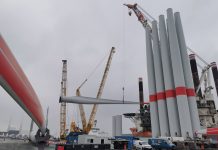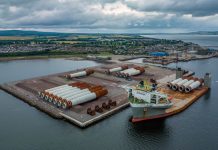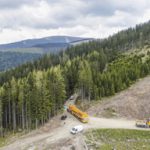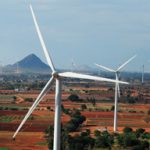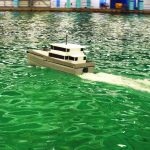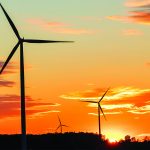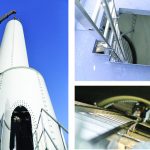Hydraulic equipment in two civil engineering labs recently pushed and pulled at test sections of a new kind of wind turbine tower, simulating the heavy, twisting loads that towers have to withstand.
In Iowa State University’s Structural Engineering Research Laboratory, an actuator rocked a 12-foot-high and 6.5-foot-wide test section with 100,000 pounds of force every 1.25 seconds. The test section’s two panels and two columns only moved a tenth of an inch, but the movement was visible, especially the swaying of the long wires attached to 65 strain and displacement sensors.
Those sensors collected data 50 times every second over weeks of fatigue testing. Meanwhile, Hartanto Wibowo, an Iowa State postdoctoral research associate, was on the lookout for tiny cracks or any other signs of wear in the test section, particularly around the prestressing cables connecting the panels and columns.
An experiment at the University of Minnesota’s MAST Laboratory tested operational and extreme wind turbine tower loads on a full-scale cross section of a tower — an assembly that was 16 feet and 7 inches high, 8 feet in diameter, and included six panels and six columns tied together with prestressing cables. Engineers took data to see if the assembled tower pieces would hold up under the loads and whether they’d transfer the load from piece to piece and act as a single unit.
Sri Sritharan, Iowa State University’s Wilson Engineering Professor in civil, construction and environmental engineering and a member of the College of Engineering’s Wind Energy Initiative, said the tower cross section had no trouble resisting the loads, and preliminary data analysis confirms that observation.
The fatigue test is ongoing with no damage detected after nearly 200,000 load cycles.
“It’s fair to say these tests were a success,” Sritharan said. “I think we’ve made great progress in validating a new concept of using prefabricated concrete for taller wind turbine towers.”
The test sections aren’t anything like the 80-meter steel wind turbine towers seen all over the Iowa countryside. They’re easily transportable precast columns and panels made from high-strength or ultra-high-performance concrete. Those columns and panels are tied together by cables to form hexagon-shaped cells that can be stacked vertically to form towers as tall as 140 meters.
Iowa State University engineers call this taller tower technology “Hexcrete” and believe it could revolutionize the production of wind energy. Sritharan said taller Hexcrete towers have many advantages over today’s steel towers, including:
• The precast concrete pieces can be easily transported and assembled on-site.
• The technology engages precast concrete companies — an established American industry — in the wind energy business.
• Concrete towers can reach beyond 80 meters, providing energy companies with access to the faster and steadier winds at 100 meters and higher.
• Taller towers allow wind energy harvesting in regions of the country where energy demand is high and favorable winds are only above 100 meters.
• Hexcrete helps reduce the cost of wind energy by cutting the production and transportation costs of towers.
Current research and development of the Hexcrete towers is supported by an 18-month, $1 million grant from the U.S. Department of Energy, a grant of $83,500 from the Iowa Energy Center, and $22,500 of in-kind contributions from Lafarge North America Inc. of Calgary, Alberta, Canada. The project’s industry partners also include the Siemens Corp.’s Corporate Technology center in Princeton, New Jersey; Coreslab Structures (OMAHA) Inc. of Bellevue, Nebraska; and BergerABAM of Federal Way, Washington.
Sritharan’s Iowa State research team also includes Julienne Krennrich, project manager and assistant director of the Engineering Research Institute; Shibin Lin, a postdoctoral research associate; and Bin Cai and Robert Peggar, doctoral students.
“Now our goal is to build a full tower in the field,” Sritharan said. “Our intent is to identify partners who can work with us on a prototype tower. We’ll also work to develop a commercialization plan.”
To advance those efforts, Sritharan’s research group will host technical and commercialization workshops next year. For more information about the workshops and the Hexcrete project, go to sri.cce.iastate.edu/hexcrete.
To watch a short video that shows how Hexcrete cells could be assembled into taller wind turbine towers, search for “120-m Tall Hexcrete Tower Assembly Options” on YouTube.
— Source: Iowa State University
















